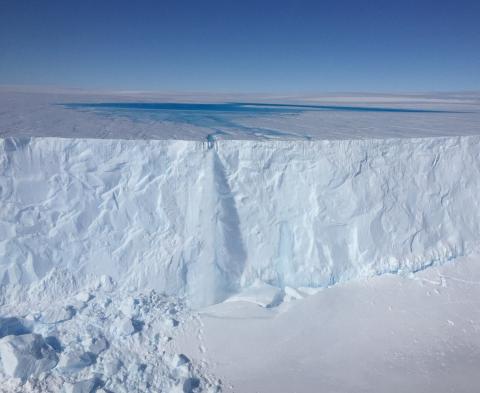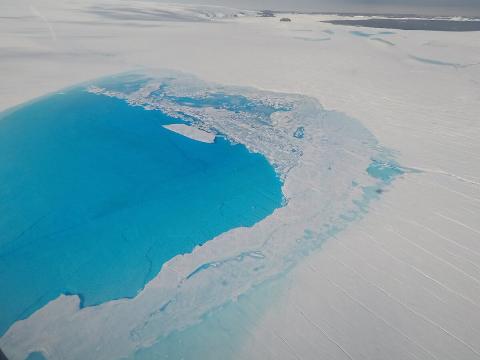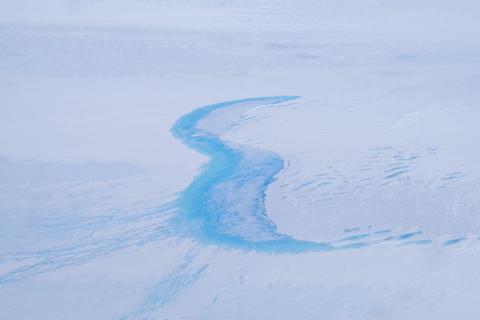This news story was first published by Durham University.
An unprecedented study looking at surface meltwater lakes around the East Antarctic Ice Sheet across a seven-year period has found that the area and volume of these lakes is highly variable year-to-year — and offers new insights into the potential impact of recent climatic change on Antarctica.
The research, led by Durham University (UK), used more than 2,000 satellite images from around the edge of the East Antarctic Ice Sheet to determine the size and volume of lakes on the ice surface. These supraglacial lakes were tracked between 2014 and 2020.
The study, published in Nature Communications with co-authors from Durham, Newcastle, and Lancaster universities and Georgia Institute of Technology, shows that lake volume varied year-to-year by as much as 200% on individual ice shelves (floating extensions of the main Antarctic ice sheet), and by around 72% overall.
Lakes were also found to be deeper and larger in warmer melt seasons and formed on some potentially vulnerable ice shelves.
It’s the first time meltwater lakes have been studied over consecutive melt seasons across the whole ice sheet, enabling the controls on their development to be explored. The work provides vital insight into why and where lakes grow and will help experts understand which ice shelves may be most at risk of breaking up as a consequence of surface melting.
“This work shows that year-to-year variability of supraglacial lakes is important on the East-Antarctic ice shelves. It demonstrates that we need to further improve our models to represent the critical factors leading to such spatio-temporal variability,” said Vincent Verjans, a postdoctoral fellow in the School of Earth and Atmospheric Sciences at Georgia Tech and member of the Institute’s Ice & Climate Group. “Capturing the correct sensitivity of lake formation to a multitude of factors such as temperature, snowfall, and wind patterns is challenging. Yet, it is necessary because supraglacial lake formation plays a critical role on the stability of ice shelves, and thus on the dynamics of ice sheets.”
“We knew that supraglacial lakes were more extensive than previously thought around the East Antarctic Ice Sheet, but until now only had snapshots of these in some years,” said Jennifer Arthur, principal investigator and Ph.D. student in the Department of Geography, Durham University. “Our study reveals these lakes change in scale far more than we originally suspected. We were surprised at how much lakes can change year-to-year between ice shelves. We explored the potential reasons for this and found that warmer summer air temperatures in Antarctica correlated with more extensive lakes.”
In addition to helping experts understand supraglacial lake formation and climatic impacts, the research seeks to predict which ice shelves may be most at risk of collapse.
“Due to climate change, air temperatures in Antarctica will continue to rise and our study suggests that this will lead to an increase in the number and volume of supraglacial lakes, which will in turn put some East Antarctic ice shelves at risk of meltwater-driven collapse,” Arthur added.
Understanding the climatic conditions controlling meltwater lake variability will also improve the accuracy of regional climate models used to replicate observations and predict future ice sheet change in Antarctica.
The study used images from the Landsat 8 satellite. Work on this study was funded through a UKRI Natural Environment Research Council doctoral studentship and individual author grants from the Natural Environment Research Council.
CITATION; Large interannual variability in supraglacial lakes around East Antarctica, Jennifer F Arthur, Chris R. Stokes, Stewart S. R. Jamieson, J. Rachel Carr, Amber A. Leeson and Vincent Verjans, published in the journal Nature Communications, DOI: 10.1038/s41467-022-29385-3
About Georgia Tech
The Georgia Institute of Technology, or Georgia Tech, is a top 10 public research university developing leaders who advance technology and improve the human condition. The Institute offers business, computing, design, engineering, liberal arts, and sciences degrees. Its nearly 44,000 students representing 50 states and 149 countries, study at the main campus in Atlanta, at campuses in France and China, and through distance and online learning. As a leading technological university, Georgia Tech is an engine of economic development for Georgia, the Southeast, and the nation, conducting more than $1 billion in research annually for government, industry, and society.




